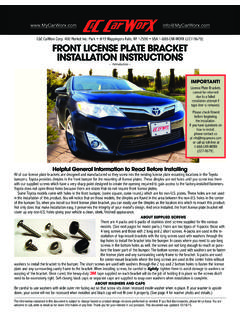Transcription of and Losses Capital Gains - irs.gov
1 Department of the Treasury Internal Revenue Service 2018 Instructions for Schedule D. Capital Gains These instructions explain how to complete Schedule D (Form 1040). Complete Form 8949 before you complete line 1b, 2, 3, 8b, 9, or 10 of Schedule D. and Losses Use Schedule D: To figure the overall gain or loss from transactions reported on Form 8949;. To report certain transactions you don't have to report on Form 8949;. To report a gain from Form 2439 or 6252 or Part I of Form 4797;. To report a gain or loss from Form 4684, 6781, or 8824;. To report a gain or loss from a partnership, S corporation, estate, or trust;. To report Capital gain distributions not reported directly on Schedule 1 (Form 1040), line 13 (or effectively connected Capital gain distributions not reported directly on Form 1040NR, line 14); and To report a Capital loss carryover from 2017 to 2018. Additional information. See Pub. 544 and Pub. 550 for more details. Section references are to the Internal General vestment in the QOF if the investment is Revenue Code unless otherwise noted.
2 Held for at least 10 years. For more in- Future Developments formation, see How to Report an Elec- tion to Defer Tax on Eligible Gain In- Instructions For the latest information about devel- vested in a QO Fund in the Instructions Other Forms You May Have for Form 8949 and Deferral of Gain In- opments related to Schedule D and its To File instructions, such as legislation enacted vested in a QOF, later. Use Form 461 to figure your excess after they were published, go to Three-year holding period for appli- business loss. ScheduleD. cable partnership interests. For tax years beginning after 2017, the Use Form 8949 to report the sale or long-term Capital Gains holding period exchange of a Capital asset (defined lat- What's New for an applicable partnership interest in- creased from more than 1 year to more er) not reported on another form or schedule and to report the income defer- Rollover of empowerment zone assets. than 3 years. The new holding period ral or exclusion of Capital Gains .
3 See the The election to rollover gain from an applies only to partnership interest held Instructions for Form 8949. Complete empowerment zone asset has expired for in connection with the performance of all necessary pages of Form 8949 before 2018. services as defined in section 1061. See you complete line 1b, 2, 3, 8b, 9, or 10. Rollovers into specialized small busi- section 1061 and Pub. 541 for details. of Schedule D. See Lines 1a and 8a, lat- ness investment companies (SSBICs). Excess business loss limitation. If you er, for more information about when Tax-free rollovers of publicly traded se- report a loss on line 7 or line 15 of your Form 8949 is needed and when it isn't. curities Gains into SSBICs are no longer Schedule D (Form 1040), you may be Use Form 4797 to report the follow- available for sales after December 31, subject to the new business loss limita- ing. 2017. tion. The disallowed loss resulting from 1. The sale or exchange of: Capital assets.
4 For dispositions after the limitation will not be reflected on Schedule D. Instead, use new Form 461 a. Real property used in your trade 2017, certain patents, inventions, mod- to figure the amount to include as in- or business;. els, or designs (whether or not patented);. secret formulas or processes; or similar come on Schedule 1 (Form 1040), b. Depreciable and amortizable tan- property are not Capital assets. See Capi- line 21. Any disallowed loss resulting gible property used in your trade or tal Asset, later. from this limitation will be treated as a business (but see Disposition of Depre- net operating loss (NOL) that must be ciable Property Not Used in Trade or Special rules for Capital Gains invested carried forward and deducted in a subse- Business in the Form 4797 instructions);. in qualified opportunity funds quent tax year. See Form 461 and its in- c. Oil, gas, geothermal, or other (QOFs). In 2018, if you have eligible structions for more information on the mineral property; and Gains and invested the Gains into a QOF, excess business loss limitation.
5 You may be able to elect to postpone d. Section 126 property. part or all of the gain that you would 2. The involuntary conversion (other otherwise include in income. You may than from casualty or theft) of property also be able to permanently exclude the used in a trade or business and Capital gain from the sale or exchange of an in- assets held more than 1 year for business D-1. May 15, 2019 Cat. No. 24331I. or profit. But see Disposition of Depre- c. From the sale of stock in trade or of property, such as inherited property. ciable Property Not Used in Trade or other property included in inventory or You need to know your basis to figure Business in the Form 4797 instructions. held mainly for sale to customers. any gain or loss on the sale or other dis- 3. The disposition of noncapital as- 3. Depreciable property used in your position of the property. You must keep sets other than inventory or property trade or business, even if it is fully de- accurate records that show the basis and, held primarily for sale to customers in preciated.
6 If applicable, adjusted basis of your the ordinary course of your trade or property. Your records should show the 4. Real estate used in your trade or business. purchase price, including commissions;. business. increases to basis, such as the cost of 4. Ordinary loss on the sale, ex- 5. For dispositions after December improvements; and decreases to basis, change, or worthlessness of small busi- 31, 2017, certain patents, inventions, such as depreciation, nondividend distri- ness investment company (section 1242) models, or designs (whether or not pa- butions on stock, and stock splits. stock. tented); secret formulas or processes; or 5. Ordinary loss on the sale, ex- similar property. See section 1221(a)(3). If you received a Schedule A to Form change, or worthlessness of small busi- 8971 from an executor of an estate or 6. A copyright; a literary, musical, ness (section 1244) stock. other person required to file an estate tax or artistic composition; a letter or mem- return, you may be required to report a 6.
7 Ordinary gain or loss on securi- orandum; or similar property that is: basis consistent with the estate tax value ties or commodities held in connection a. Created by your personal efforts; of the property. with your trading business, if you previ- b. Prepared or produced for you (in ously made a mark-to-market election. For more information on consistent the case of a letter, memorandum, or See Traders in Securities, later. basis reporting and basis generally, see similar property); or Column (e) Cost or Other Basis in the Use Form 4684 to report involuntary c. Received under circumstances Instructions for Form 8949, and the fol- conversions of property due to casualty (such as by gift) that entitle you to the lowing publications. or theft. basis of the person who created the Pub. 551, Basis of Assets. Use Form 6781 to report Gains and property or for whom the property was Pub. 550, Investment Income and Losses from section 1256 contracts and prepared or produced.
8 Expenses (Including Capital Gains and straddles. But see the Tip about certain musical Losses ). Use Form 8824 to report like-kind compositions or copyrights below. Short- or Long-Term Gain or exchanges. A like-kind exchange occurs 7. A Government publication, Loss when you exchange business or invest- including the Congressional Record, that ment property for property of a like you received from the government for Report short-term Gains or Losses in Part kind. less than the normal sales price, or that I. Report long-term Gains or Losses in you received under circumstances that Part II. The holding period for Use Form 8960 to figure any net in- short-term Capital Gains and Losses is entitle you to the basis of someone who vestment income tax relating to Gains generally 1 year or less. The holding pe- received the publication for less than the and Losses reported on Schedule D, in- riod for long-term Capital Gains and los- normal sales price. cluding Gains and Losses from a securi- ses is generally more than 1 year.
9 How- ties trading activity. 8. Certain commodities derivative ever, beginning in 2018, the long-term financial instruments held by a dealer holding period for certain Gains with re- Capital Asset and connected to the dealer's activities spect to applicable partnership inter- Most property you own and use for per- as a dealer. See section 1221(a)(6). ests is more than 3 years. See Pub. 541. sonal purposes or investment is a Capital 9. Certain hedging transactions en- for more information. asset. For example, your house, furni- tered into in the normal course of your ture, car, stocks, and bonds are Capital trade or business. See section 1221(a) For more information about holding assets. A Capital asset is any property (7). periods, see the Instructions for Form owned by you except the following. 8949. 10. Supplies regularly used in your 1. Stock in trade or other property trade or business. Capital Gain Distributions included in inventory or held mainly for These distributions are paid by a mutual sale to customers.
10 But see the Tip about You can elect to treat as Capital TIP assets certain musical composi- fund (or other regulated investment certain musical compositions or copy- company) or real estate investment trust rights, later. tions or copyrights you sold or exchanged. See Pub. 550 for details. from its net realized long-term Capital 2. Accounts or notes receivable: Gains . Distributions of net realized a. For services rendered in the ordi- Basis and Recordkeeping short-term Capital Gains aren't treated as nary course of your trade or business, Capital Gains . Instead, they are included Basis is the amount of your investment b. For services rendered as an em- on Form 1099-DIV as ordinary divi- in property for tax purposes. The basis ployee, or dends. of property you buy is usually its cost. There are special rules for certain kinds D-2. Enter on Schedule D, line 13, the to- home during the 2-year period ending on for 2 of the 5 years before the sale, she tal Capital gain distributions paid to you the date of the sale or exchange of your meets the ownership and use require- during the year, regardless of how long home.












